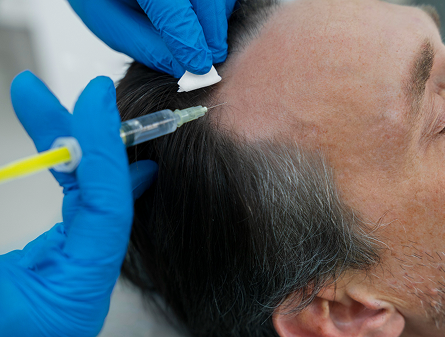A hair transplant is a surgical procedure where healthy hair is extracted from the donor area of the scalp and implanted into balding areas. As part of the procedure, small grafts are removed from healthy areas, and once they are positioned and healed, they can grow new hairs. Hair loss shampoo can help to regrow your hair.
The effectiveness of shampoo for hair regrowth can depend on the ingredients used and whether they can help with your cause of hair loss. Transplanted hair can have a high survival rate of up to 90% if aftercare instructions are carefully followed.
Hair loss shampoos often contain natural ingredients that can enable hair growth. Discover the differences between a hair transplant and hair loss shampoo in the comparison table below.
- Hair transplants surgically relocate follicles to restore density and natural growth.
- Unlike hair loss shampoo, they offer a permanent and noticeable outcome.
- Hair loss shampoo helps maintain scalp health and may reduce shedding.
- Compared to transplants, it provides surface-level benefits without regrowing lost hair.
- Transplants are performed in one or two sessions, with results visible within 6–12 months.
- Minimal maintenance is needed after healing.
- Hair loss shampoos typically cost $10–$40 per bottle.
- Unlike transplants, costs are lower up front but accumulate with continued use.
- Transplants are performed in one or two sessions, with results visible within 6–12 months.
- Minimal maintenance is needed after healing.
- Hair loss shampoo must be used regularly, often several times a week.
- Compared to transplants, results are slower, subtle, and require continuous upkeep.
- Hair loss shampoo must be used regularly, often several times a week.
- Compared to transplants, results are slower, subtle, and require continuous upkeep.
- Hair loss shampoo is applied topically and washed off after a short period.
- Unlike transplants, it’s non-invasive and easy to integrate into daily routines.
- Hair transplants carry surgical risks such as scarring, swelling, and infection.
- Safe when performed by a qualified specialist.
- Hair loss shampoos are generally safe but may cause dryness or irritation in sensitive scalps.
- Compared to surgery, they carry fewer risks and no downtime.
- Hair transplants require skilled surgery and recovery time.
- Once complete, no daily routine is needed for transplanted areas.
- Hair loss shampoo is used like regular shampoo with no additional learning curve.
- Unlike transplants, it’s easy to implement without expert involvement.
- Specialist clinics with limited locations and higher costs offer hair transplants.
- Less accessible than over-the-counter alternatives.
- Hair loss shampoos are widely available in Australian pharmacies and online.
- More accessible and budget-friendly than hair transplants.
- Hair transplants offer permanent results in treated areas.
- No need for ongoing aftercare once follicles take hold in the scalp.
- Hair loss shampoo delivers benefits only with consistent use.
- Unlike transplants, stopping use may reverse progress.
- Hair transplants can be supported with shampoos, minoxidil, or vitamins post-surgery.
- Commonly used in multi-modal treatment plans.
- Hair loss shampoos are often combined with oral or topical medications.
- Compared to transplants, they play a supportive rather than primary role.
- Hair transplants appeal to users seeking a bold, transformative, and lasting solution.
- Viewed as a permanent but invasive hair loss solution.
- Hair loss shampoo appeals to those preferring low-effort, non-invasive care.
- Unlike transplants, it offers a more passive and familiar approach.
- Hair transplants restore hair density but don’t directly improve scalp health.
- Focused on cosmetic restoration.
- Hair loss shampoos may soothe irritation and remove buildup for a cleaner scalp.
- Compared to transplants, they target the scalp environment rather than altering hair follicle growth.
- Hair transplants produce one-time clinical waste during surgery.
- Minimal long-term environmental impact.
- Hair loss shampoos generate ongoing packaging waste from plastic bottles.
- Less sustainable than a single surgical treatment.
Shop our hair solutions
We are committed to providing affordable hair regeneration services for people all over Australia. Our formula can help you regain your confidence.
Shop Now

Hair Transplant vs Shampoo For Regrowth Solutions Comparison Summary
A hair transplant can provide effective results in covering balding areas with new hair growth. It is most effective for those who are in the early stages of hair loss compared to later-stage hair loss as the results can vary depending on the number of healthy hairs available on the person’s scalp.
The effectiveness of hair loss shampoo can vary greatly depending on the quality of ingredients used and the cause of your hair loss. Depending on the formulation, hair loss shampoos can have an impact on scalp health, inflammation and hormones, which can be influential on hair growth. A hair transplant can be an expensive investment.
Typically it is a once-off procedure so it could be a good long-term investment. The cost can vary depending on where you choose to get the procedure done, the quality and reputation of the clinic as well as the experience and expertise of the surgeon.
Hair loss shampoo is comparatively cheaper but may need to be used in the long run to maintain results and may not be as effective as a hair transplant in providing new hair growth.
User Guidance
A hair transplant is usually a one-day procedure that can take anywhere from 4 to 8 hours, but multiple sessions may be required, depending on the number of grafts you are receiving. The preparation and weeks of aftercare should also be factored into the total treatment time, but following the recovery, you can enjoy long-term results.
Hair loss shampoo can easily be incorporated into your daily routine as a treatment but requires consistent use to see results. If the treatment is discontinue,d the positive results may reverse. A hair transplant comes with some potential side effects as it is a surgical procedure.
These include swelling and bleeding but may depend on the skill of the surgeon and the quality of the clinic. Hair loss shampoo is typically considered to be safe but some formulations can interfere with your endocrine system, causing disruptions to your hormones.
Take Our Hair Loss Quiz to See Which Treatment Suits You?
Take A Hair Quiz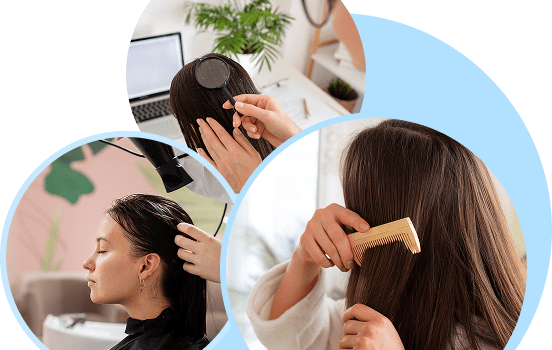

Frequently Asked Questions
We have put some commonly asked questions.
Nunc scelerisque tincidunt elit. Vestibulum non mi ipsum. Cras pretium suscipit tellus sit amet aliquet. Vestibulum maximus lacinia massa nontor.
Platelet-rich plasma (PRP) treatment involves drawing blood from the patient, isolating the beneficial nutrients and injecting it into the scalp where hair loss is occurring. This promotes hair growth and has many other applications from encouraging healing to skin rejuvenation.
Platelet-rich plasma (PRP) treatment involves drawing blood from the patient, isolating the beneficial nutrients and injecting it into the scalp where hair loss is occurring. This promotes hair growth and has many other applications from encouraging healing to skin rejuvenation.
Platelet-rich plasma (PRP) treatment involves drawing blood from the patient, isolating the beneficial nutrients and injecting it into the scalp where hair loss is occurring. This promotes hair growth and has many other applications from encouraging healing to skin rejuvenation.
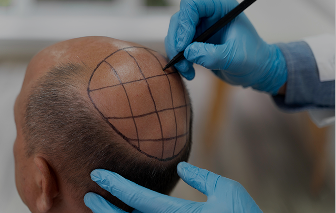
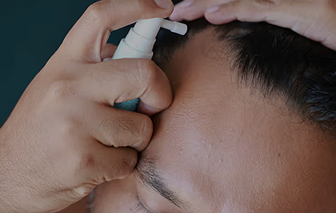




 See All
See All